Attitudes to Exotic Parakeets: A Comparative Case Study and Citizen Science Review
Abstract
1. Introduction
1.1. Invasive, Non-Native Species
1.2. Attitudes to Non-Native Species
1.3. The Arrival and Establishment of Ring-Necked Parakeets in England
1.4. Target Regions
1.5. Research Questions
2. Materials and Methods
- Participant details;
- Participant’s interest in wildlife;
- Awareness of ring-necked parakeets;
- Level of exposure to ring-necked parakeets;
- Perceptions and attitudes to ring-necked parakeets;
- Knowledge of and attitudes towards non-native species;
- Attitudes to and perceptions of non-native wildlife management issues.
3. Results
3.1. Local Records from Birdwatchers
3.1.1. The Sheffield Area Case Study
3.1.2. The Greater London Case Study
3.1.3. Records from the Citizen Science Project
- (1)
- The need to recognise ‘menacing’ and ‘detrimental’ impacts of these species on ecosystems. Sheffield: “I might be able to walk up the valley and see the beautiful native red squirrel. Unfortunately, because of the impact of the non-native grey squirrel, I can no longer do that.” Greater London: “They should all be eradicated especially this species. New Zealand has realized this; we should follow suit before it is too late.”
- (2)
- Species should be ‘judged’ on their merits on a case-by-case basis in relation to their potential negative impacts to native wildlife. Sheffield: “If damaging to species—plants or animals then I feel invasive, non-native wildlife would need to be controlled.” Greater London: “I feel if they are detrimental to our native wildlife then something should be done.”
- (3)
- Change is inevitable and part of a dynamic and evolving ecosystem. Sheffield: “As the world changes, it is harder to control—crayfish, harlequin ladybirds, grey squirrels… they are all here and ‘part of the landscape’ that I have grown up with.” Greater London: “No problem with it. What right do we have to decide what lives or dies?”
4. Discussion
4.1. Issues, Perceptions, and Establishment
- Secondly, whilst parakeets are inherently adaptable, flexible foragers, an abundant food supply throughout the year from enthusiastic, nature-loving humans, is an enormous advantage. Parakeets are known to use bird-feeders mostly in the breeding season and during the winter. This enables higher breeding densities of birds to be established and maintained [47]. Especially during the breeding season, food availability may limit spread into more rural areas.
- Thirdly, Strubbe and Matthysen [70], showed the abundance of parakeets to be highest in suburban and urban forests, with the proportion of breeding birds correlated with the density of potential nest sites. Parakeets require a suitable breeding habitat, such as the cavities provided by older trees in forests, woods, gardens, and city parks.
4.2. Novelty and Attractiveness
4.3. Parakeet Impacts
4.4. Acceptance of Controls and Culls
4.5. Future Scenarios and Citizen Science
5. Conclusions
Author Contributions
Funding
Data Availability Statement
Acknowledgments
Conflicts of Interest
Appendix A
| c. 1990 | Aviary in Sheffield 5 near Longley Park | African ring-necked parakeets escaped from aviary. |
| 1980s–1991 | * Moor Lane, Bishopthorpe, York | Small flock in gardens with fruit trees |
| 1999 | Carterknowle Road, Sheffield | One sat on television aerial |
| 1999 | * Nidderdale, North Yorkshire | Up to 4 visiting garden to feed [one with an eye infection died] |
| 2005-9 | * Cottingham, East Yorkshire | Several flying in area and roosting around St Mary’s Church |
| 2006-9 | Near Park Road, Hartlepool | Small colony recorded |
| 2007 | Chesterfield | |
| 2007 | * Little Ribston near Wetherby | 1 visiting garden feeders |
| 2007 | Meersbrook, Sheffield | 2–3 |
| 2007 | Heeley, Sheffield | Single |
| 2008 | Heeley, Sheffield | Single |
| 2008 | Ecclesfield, Sheffield | 2 |
| 2008 | Beighton, Sheffield | |
| 2008-9 | * Armley, Leeds | Regular sightings |
| 2009 | Heeley, Sheffield | Single |
| 2009 | Fulwood, Sheffield | Several feeding on peanuts |
| 2009 | Botanical Gardens, Sheffield | Several |
| 2009 | Beighton, Sheffield | Regularly seen |
| 2009 | Broom, Rotherham | |
| 2009 | Wybourn, Sheffield | |
| 2009 | Wincobank, Sheffield | In garden overlooking Woolley Wood |
| 2009 | On television aerial, Woodseats, Sheffield | 1 |
| 2009 | Hunter’s Bar, Sheffield | Several |
| 2009 | Garden feeder in Woodseats, Sheffield | |
| 2009 | Flying over garden in Woodseats, Sheffield | 2 |
| 2009 | Woodseats, Sheffield | 2–3 in garden |
| 2009 | Ecclesfield, Sheffield | Regular sightings |
| 2009 | Millhouses, Sheffield | Regular and feeding in garden |
| 2009 | Millhouses, Sheffield | Regular sightings |
| 2009 | Walton Lane, Sandal nr Wakefield | 1 in garden |
| 2009 | * Temple Newsam, Leeds | 1 feeding in garden |
| 2009 | * north Hull | 1 in garden feeding on fat-balls |
| 2009 | * Little Ribston near Wetherby | 1 visiting garden feeders |
| 2009 | Yeadon nr Leeds | 1 in tree near garden |
| 2009 | South Milford, Leeds | 1 feeding regularly in garden |
| 2010 | Meersbrook, Sheffield | Singles |
| 2010 | Greasborough, South Yorkshire | Several |
| 2010 | Whiston, Rotherham | In garden feeding on suet cake and sunflower seed |
| 2010 | Nether Edge, Sheffield | 2 feeding on peanuts in garden |
| 2013 | Dore, Sheffield | 2–3 feeding in garden |
| 2015 | Handsworth, Sheffield | Bowden Housteads Wood |
| 2015 | Handsworth, Sheffield | 1 in garden |
| 2015 | Warminster Road, Sheffield | 2 or more in and around gardens |
| 2015 | Nether Edge, Sheffield | In garden |
| 2015 | Warminster Road, Sheffield | |
| 2015 | Warminster Road/Ketton Avenue, Sheffield | Regular sightings |
| 2016 | Nether Edge & Woodseats Allotments, Sheffield | Single Alexandrine parakeet for several months |
| 2016 | Ketton Avenue, Sheffield | Flying over garden |
| 2016 | Graves Park/Norton, Sheffield | Regularly seen over a wide area and visiting garden feeders |
| 2017 | Bradway/Abbeydale/Ecclesall, Sheffield | Regularly seen over a wide area and visiting garden feeders |
| 2017 | Woodseats, Sheffield | Regularly seen and visiting garden feeders |
| 2017 | Graves Park/Norton, Sheffield | Regularly seen over a wide area and visiting garden feeders |
| 2017 | Dronfield, Derbyshire | Flocks of up to 20 reported |
| 2017 | Millhouses, Sheffield | Flocks of up to 20 reported |
| 2017-2019 | Graves Park/Norton area, Sheffield | Frequent records and flocks of up to 10–15 |
| 2020 and later | Fulwood & Graves Park | A pair flew through garden and then seen elsewhere |
| 2020 | Ossett, West Yorkshire | Seen and heard in the area |
| 2021 | Shirtcliff, Sheffield | Birds reported from the woods |
| 2022 | Bracken Hill, Burncross, Sheffield | Pair feeding regularly in garden in winter |
| 2023 | Woods at Northern General Hospital, Sheffield | Hundreds in the woods on Barnsley Road |
| 2023 | Woods at Northern General Hospital, Sheffield | I work at the Northern General Hospital and there are hundreds in the woods on Barnsley Road. I love trying to spot them, they usually sit right at the top of the trees and make a very distinctive squawk!! Best to spot them from the driveway inside the hospital, walking on the road towards the Clock Tower. February 2023 |
| 2023 | Fleets Dam [The Fleets], Barnsley | Seen regularly |
| 2023 | Hutcliffe Wood Crematorium, Sheffield | Recorded regularly |
| 2023 | Graves Park, Sheffield | Grey squirrel predating parakeet nest in beech tree |
| 2023 | Graves Park, Sheffield | Successful breeding reported |
| 2024 | Fulwood, Sheffield | Up to 5 feeding in garden late summer, 6 in winter |
| 2024 | Northern General Hospital, Sheffield | 4 feeding in woodland |
| 2024 | Beauchief, Sheffield | Up to 4 feeding on peanuts and sunflower hearts |
| 2024 | Graves Park, Sheffield | Good views of parakeets eating acorns. |
| 2024 | Graves Park, Sheffield | Up to 4 Alexandrine parakeets including prospecting a nest site |
| 2024 | Norton, Sheffield | Up to 4 Alexandrine parakeets, 2 males, 2 females, on garden feeders |
| 2025 | Bolsover, North Derbyshire | I read with interest and dismay your recent article in Bolsover Magazine 25 headed ‘An Explosion of Parakeets’. Experienced them in Kew Gardens, London. |
| 2025 | Beauchief, Sheffield | Moved from London and concerned about negative impacts of parakeets in numbers. |
| 2025 | Carr Lodge Park, Horbury, nr Wakefield | Pair reported for the first time in 20 years in 2024. |
| 2025 | Beauchief, Sheffield | Several in garden and local woods – first in over 20 years. |
| 2025 | Ecclesfield, north Sheffield | First seen in 2023; up to 12 in garden 2024. Aggressive to smaller birds. |
| 2025 | Denby Dale, Huddersfield | One visiting garden feeders. |
References
- McCarthy, M. Britain’s naturalised parrot now officially a pest. The Independent, 30 September 2009. [Google Scholar]
- Moss, S. Parakeets flee the scrum. The Guardian, 18 October 2006; p. G2. [Google Scholar]
- Butler, C.J.; Cresswell, W.; Perrins, C. The breeding biology of Rose-ringed Parakeets Psittacula krameri in England during a period of rapid population expansion. Bird Study 2013, 60, 527–532. [Google Scholar] [CrossRef]
- Hunt, N.; Mitchell, T. The Parakeeting of London; Paradise Road: London, UK, 2019. [Google Scholar]
- Pithon, J.A.; Dytham, C. Determination of the origin of British feral Rose-ringed Parakeets. Br. Birds 2001, 94, 74–79. [Google Scholar]
- Cramp, S. (Ed.) The Birds of the Western Palearctic; Oxford University Press: Oxford, UK, 1988; Volume 5. [Google Scholar]
- Selge, S.; Fischer, A.; van der Wal, R. Public and professional views on invasive non-native species—A qualitative social scientific investigation. Biol. Conserv. 2011, 144, 3089–3097. [Google Scholar] [CrossRef]
- Shackleton, R.; Richardson, D.M.; Shackleton, C.H.L.; Bennett, B.; Crowley, S.L.; Dehnen-Schmutz, K.; Estevez, R.; Fischer, A.; Kueffer, C.; Kull, C.A.; et al. Explaining people’s perceptions of invasive alien species: A conceptual framework. J. Environ. Manag. 2019, 229, 10–26. [Google Scholar] [CrossRef]
- Rotherham, I.D. Exotic and Alien Species in a Changing World. ECOS 2009, 30, 42–49. [Google Scholar]
- Rotherham, I.D. Chapter 15: History and Perception in animal and plant invasions—the case of acclimatisation and wild gardeners. In Invasive and Introduced Plants and Animals: Human Perceptions, Attitudes and Approaches to Management; Rotherham, I.D., Lambert, R., Eds.; EARTHSCAN: London, UK, 2011; pp. 233–248. [Google Scholar]
- Rotherham, I.D.; Lambert, R.A. (Eds.) Good science, good history and pragmatism: Managing the way ahead. In Invasive and Introduced Plants and Animals: Human Perceptions, Attitudes and Approaches to Management; EARTHSCAN: London, UK, 2011; pp. 355–366. [Google Scholar]
- Rotherham, I.D.; Lambert, R.A. (Eds.) Invasive and Introduced Plants and Animals: Human Perceptions, Attitudes and Approaches to Management; EARTHSCAN: London, UK, 2011. [Google Scholar]
- Rotherham, I.D. Recombinant Ecology—A Hybrid Future? Springer Briefs; Springer: Dordrecht, The Netherlands, 2017. [Google Scholar]
- Sharp, R.L.; Larson, L.R.; Green, G.T. Factors influencing public preferences for invasive alien species management. Biol. Conserv. 2011, 144, 2097–2104. [Google Scholar] [CrossRef]
- Tayleur, J. Little Green Aliens? BTO News, November–December 2008. pp. 16–17.
- Self, A. The Birds of London; Bloomsbury Publishing: London, UK, 2014. [Google Scholar]
- Crowley, S.L.; Hinchliffe, S.; Mcdonald, R.A. The parakeet protectors: Understanding opposition to introduced species management. J. Environ. Manag. 2017, 229, 120–132. [Google Scholar] [CrossRef]
- Rotherham, I.D.; Boardman, S. Who says the public only love red squirrels? ECOS 2006, 27, 28–35. [Google Scholar]
- Watchman, M.J. The Ring-Necked Parakeet in Sheffield: Perceptions of a Non-Native Species. Master’s Dissertation, Sheffield Hallam University, Sheffield, UK, 2018. Unpublished. [Google Scholar]
- Williams, F.; Eschen, R.; Harris, A.; Djeddour, D.; Pratt, C.; Shaw, R.S.; Varia, S.; Lamontagne-Godwin, J.; Thomas, S.E.; Murphy, S.T. The Economic Cost of Invasive Non-Native Species on Great Britain; CABI: Oxford, UK, 2010. [Google Scholar]
- Brock, C.; Richardson, S. The Monk Parakeet (Myiopsitta monachus): An Argument Against Eradication of the Feral of This Species in the UK. 2011. Available online: https://hertsmere.moderngov.co.uk/documents/s15039/Appendix%20B.pdf (accessed on 8 June 2025).
- Dunn, M.; Marzano, M.; Forster, J.; Gill, R.M.A. Public attitudes towards “pest” management: Perceptions on squirrel management strategies in the UK. Biol. Conserv. 2018, 222, 52–63. [Google Scholar] [CrossRef]
- Milfont, T.L.; Duckitt, J. The Environmental Attitudes Inventory: A valid and reliable measure to assess the structure of environmental attitudes. J. Environ. Psychol. 2010, 30, 80–94. [Google Scholar] [CrossRef]
- Rice, C.N. Abundance, Impacts and Resident Perceptions of Non-Native Common Pheasants (Phasianus colchicus) in Jersey, UK Channel Islands. Master’s Thesis, University of Kent, Canterbury, UK, 2016. Unpublished. [Google Scholar]
- Toland, E.; Warwick, C.; Arena, P.C. Pet Hate: Exotic pet-keeping is on the rise despite decades of initiatives aimed at reducing the trade of exotic and rare animals. Biologist 2012, 59, 14–18. [Google Scholar]
- Ancillotto, L.; Strubbe, D.; Menchetti, M.; Mori, E. An overlooked invader? ecological niche, invasion success and range dynamics of the alexandrine parakeet in the invaded range. Biol. Invasions 2016, 18, 583–595. [Google Scholar] [CrossRef]
- Robertson, P.; Adriaens, T.; Caizergues, A.; Cranswick, P.; Devos, K.; Gutiérrez-Expósito, C.; Henderson, I.; Hughes, B.; Mill, A.C.; Smith, G. Towards the European eradication of the North American Ruddy Duck. Biol. Invasions 2015, 17, 9–12. [Google Scholar] [CrossRef]
- Rotherham, I.D. Alien Plants and the Human Touch. J. Pract. Ecol. Conserv. Spec. Ser. 2005, 4, 63–76. [Google Scholar]
- Cocker, M.; Mabey, R. Birds Britannica; Chatto & Windus: London, UK, 2005. [Google Scholar]
- García-Llorente, M.; Martín-López, B.; González, J.A.; Alcorlo, P.; Montes, C. Social perceptions of the impacts and benefits of invasive alien species: Implications for management. Biol. Conserv. 2008, 141, 2969–2983. [Google Scholar] [CrossRef]
- Jeschke, J.M.; Bacher, S.; Blackburn, T.M.; Dick, J.T.A.; Essl, F.; Evans, T.; Gaertner, M.; Hulme, P.E.; Kühn, I.; Mrugała, A.; et al. Defining the impact of Non-Native species. Conserv. Biol. 2014, 28, 1188–1194. [Google Scholar] [CrossRef]
- Pimentel, D.; Zuniga, R.; Morrison, D. Update on the environmental and economic costs associated with alien-invasive species in the United States. Ecol. Econ. 2005, 52, 273–288. [Google Scholar] [CrossRef]
- Vitousek, P.D.; Antonio, C.; Loope, L.; Westbrooks, R. Biological invasions as global environmental change. Am. Sci. 1996, 84, 468. [Google Scholar]
- Manchester, S.J.; Bullock, J.M. The impacts of non-native species on UK biodiversity and the effectiveness of control. J. Appl. Ecol. 2000, 37, 845–864. [Google Scholar] [CrossRef]
- Jaeger, H.; Kowarik, I.; Tye, A. Destruction without extinction: Long-term impacts of an invasive tree species on Galapagos highland vegetation. J. Ecol. 2009, 97, 1252–1263. [Google Scholar] [CrossRef]
- Didham, R.K.; Tylianakis, J.M.; Hutchison, M.A.; Ewers, R.M.; Gemmell, N.J. Are invasive species the drivers of ecological change? Trends Ecol. Evol. 2005, 20, 470–474. [Google Scholar] [CrossRef] [PubMed]
- Sagoff, M. Do non-native species threaten the natural environment? J. Agric. Environ. Ethics 2005, 18, 215–236. [Google Scholar] [CrossRef]
- Long, J.L. Introduced Birds of the World; David & Charles: Newton Abbot, UK, 1981. [Google Scholar]
- Lever, C. The Naturalized Animals of the British Isles; Hutchinson & Co. (Publishers Ltd.): London, UK, 1977. [Google Scholar]
- Lever, C. The Naturalized Animals of Britain and Ireland; New Holland: London, UK, 2009. [Google Scholar]
- Pithon, J.; Dytham, C. Census of the British Ring-Necked Parakeet Psittacula krameri population by simultaneous counts of roosts. Bird Study 1999, 46, 112–115. [Google Scholar] [CrossRef]
- Pithon, J.; Dytham, C. Distribution and population development of introduced Ring-Necked Parakeet Psittacula krameri in Britain between 1983 and 1998. Bird Study 2002, 49, 110–117. [Google Scholar] [CrossRef]
- Frith, M. As British as curry? Hot and bothered over parakeets. ECOS 2010, 31, 11–15. [Google Scholar]
- Peck, H.L.; Pringle, H.E.; Marshall, H.H.; Owens, I.P.; Lord, A.M. Experimental evidence of impacts of an invasive parakeet on foraging behavior of native birds. Behav. Ecol. 2014, 25, 582–590. [Google Scholar] [CrossRef]
- Strubbe, D.; Matthysen, E. Invasive Ring-necked Parakeets Psittacula krameri in Belgium: Habitat selection and impact on native birds. Ecography 2007, 30, 578–588. [Google Scholar] [CrossRef]
- Tayleur, J.R. A comparison of the establishment, expansion and potential impacts of two introduced parakeets in the United Kingdom. In Proceedings of the Conference: The Impacts of Non-Native Species; British Ornithologists’ Union: Peterborough, UK, 2010; pp. 1–12. [Google Scholar]
- Clergeau, P.; Vergnes, A. Bird feeders may sustain feral Rose-ringed Parakeets Psittacula krameri in temperate Europe. Wildl. Biol. 2011, 17, 248–252. [Google Scholar] [CrossRef]
- Fischer, A.; Selge, S.; Van Der Wal, R.; Larson, B. The public and professionals reason similarly about the management of non-native invasive species: A quantitative investigation of the relationship between beliefs and attitudes. PLoS ONE 2014, 9, e105495. [Google Scholar] [CrossRef]
- Tweddle, J.C.; Robinson, L.D.; Pocock, M.J.O.; Roy, H.E. Guide to Citizen Science: Developing, Implementing and Evaluating Citizen Science to Study Biodiversity and the Environment in the UK; Natural History Museum and NERC Centre for Ecology & Hydrology for UK-EOF: London, UK, 2012. [Google Scholar]
- Bryman, A.; Bell, E. Business Research Methods, 3rd ed.; Oxford University Press: Oxford, UK, 2011. [Google Scholar]
- Biernacki, P.; Waldorf, D. Snowball sampling: Problems and techniques of chain referral sampling. Sociol. Methods Res. 1981, 10, 141–163. [Google Scholar] [CrossRef]
- Joshi, A.; Kale, S.; Chandel, S.; Pal, D.K. Likert Scale: Explored and Explained. Br. J. Appl. Sci. Technol. 2015, 7, 396–403. [Google Scholar] [CrossRef]
- Svensson, E. Guidelines to statistical evaluation of data from rating scales and questionnaires. J. Rehabil. Med. 2001, 33, 47–48. [Google Scholar] [CrossRef] [PubMed]
- Saldaña, J. The Coding Manual for Qualitative Researchers, 3rd ed.; SAGE: Los Angeles, CA, USA, 2016. [Google Scholar]
- Smith, A.H.V. (Ed.) Birds of the Sheffield Area; Sheffield City Museums & Sorby Natural History Society: Sheffield, UK, 1974. [Google Scholar]
- Hornbuckle, J.; Herringshaw, D. (Eds.) Birds of the Sheffield Area including the North-East Peak District; Sheffield Bird Study Group & Sheffield City Libraries: Sheffield, UK, 1985. [Google Scholar]
- Wood, D.; Hill, R. (Eds.) Breeding Birds of the Sheffield Area including the North-East Peak District; Sheffield Bird Study Group: Sheffield, UK, 2013. [Google Scholar]
- Frost, R.A. Birds of Derbyshire; Moorland Publishing Company: Buxton, UK, 1978. [Google Scholar]
- Frost, R.; Shaw, S. (Eds.) The Birds of Derbyshire; Liverpool University Press: Liverpool, UK, 2013. [Google Scholar]
- Beevers, M. Monthly records. In Bulletin; Derbyshire Ornithological Society: Derby, UK, 2021. [Google Scholar]
- Garton, S. (Ed.) Derbyshire Bird Report 2023; Derbyshire Ornithological Society: Derby, UK, 2024. [Google Scholar]
- Dobbs, A. (Ed.) The Birds of Nottinghamshire Past and Present; David & Charles: Newton Abbot, UK, 1975. [Google Scholar]
- Reece, J.; Crouch, N.; Parkin, D.; du Feu, C.; Ellis, B. The Birds of Nottinghamshire; Liverpool University Press: Liverpool, UK, 2019. [Google Scholar]
- Mather, J.R. The Birds of Yorkshire; Croom Helm: London, UK, 1986. [Google Scholar]
- Wilson, A.; Slack, R. Rare and Scarce Birds in Yorkshire; Biddles Ltd.: Guildford, UK, 1996. [Google Scholar]
- Rhodes, R.J. Birds in the Doncaster District; Doncaster and District Ornithological Society: Doncaster, UK, 1988. [Google Scholar]
- Dobbs, G. Yorkshire Bird Report 2017; Yorkshire Naturalists’ Union: York, UK, 2018. [Google Scholar]
- Dobbs, G. Yorkshire Bird Report 2018/19; Yorkshire Naturalists’ Union: York, UK, 2020. [Google Scholar]
- Fraticelli, F. The Rose-ringed Parakeet Psittacula krameri in an urban park: Demographic trend, interspecific relationships and feeding preferences (Rome, central Italy). Avocetta 2010, 38, 23–28. [Google Scholar]
- Strubbe, D.; Matthysen, E. Establishment success of invasive ring-necked and monk parakeets in Europe. J. Biogeogr. 2009, 36, 2264–2278. [Google Scholar] [CrossRef]
- Keller, R.P.; Cadotte, M.W.; Sandiford, G. Invasive Species in a Globalized World: Ecological, Social, and Legal Perspectives on Policy; University of Chicago Press: Chicago, IL, USA, 2014. [Google Scholar]
- Blackburn, T.M.; Gaston, K.J. Contribution of non-native galliforms to annual variation in biomass of British birds. Biol. Invasions 2021, 23, 1549–1562. [Google Scholar] [CrossRef]
- Bremner, A.; Park, K. Public Attitudes to the Management of Invasive Non-Native Species in Scotland. Biol. Conserv. 2007, 139, 306–314. [Google Scholar] [CrossRef]
- Hernández-Brito, D.; Carrete, M.; Ibáñez, C.; Juste, J.; Tella, J.L. Nest-site competition and killing by invasive parakeets cause the decline of a threatened bat population. R. Soc. Open Sci. 2018, 5, 172477. [Google Scholar] [CrossRef]
- Strubbe, D.; Matthysen, E.; Graham, C.H. Assessing the potential impact of invasive ring-necked parakeets Psittacula krameri on native nuthatches Sitta europeae in Belgium. J. Appl. Ecol. 2010, 47, 549–557. [Google Scholar] [CrossRef]
- Seastedt, T.R. Biological control of invasive plant species: A reassessment for the Anthropocene. New Phytol. 2015, 205, 490–502. [Google Scholar] [CrossRef]
- Avery, M.; Shiels, A. Monk and Rose-Ringed Parakeets. In Ecology and Management of Terrestrial Vertebrate Invasive Species in the United States; Pitt, W.C., Beasley, J.C., Witmer, G.W., Eds.; CRC Press: Boca Raton, FL, USA; Taylor & Francis: Boca Raton, FL, USA, 2018; pp. 333–357. [Google Scholar]
- Carrington, D. Eradication efforts bring UK’s monk parakeet numbers down to last 50. The Guardian, 24 September 2014. [Google Scholar]
- Wild Birds: Licence to Kill or Take for Conservation Purposes (GL4). Available online: https://www.gov.uk/government/publications/wild-birds-licence-to-kill-or-take-for-conservation-purposes-gl40 (accessed on 30 January 2022).
- Tigwell, R. Defra Is Not Planning Ring-Necked Parakeet Cull. SW Londoner, 11 March 2021. Available online: https://www.swlondoner.co.uk/news/11032021-defra-is-not-planning-ring-necked-parakeet-cull/ (accessed on 2 January 2022).
- Lurz, P.W.W.; Garson, P.J.; Rushton, S.P. The ecology of squirrels in spruce dominated plantations: Implications for forest management. For. Ecol. Manag. 1995, 79, 79–90. [Google Scholar] [CrossRef]
- Booy, O.; Mill, A.; Roy, H.; Hiley, A.; Moore, N.; Robertson, P.; Baker, S.; Brazier, M.; Bue, M.; Bullock, R.; et al. Risk management to prioritise the eradication of new and emerging invasive non-native species. Biol. Invasions 2017, 19, 2401–2417. [Google Scholar] [CrossRef]
- Hobbs, R.J.; Higgs, E.S.; Hall, C. Novel Ecosystems: Intervening in the New Ecological World Order; Wiley-Blackwell: Oxford, UK, 2013. [Google Scholar]
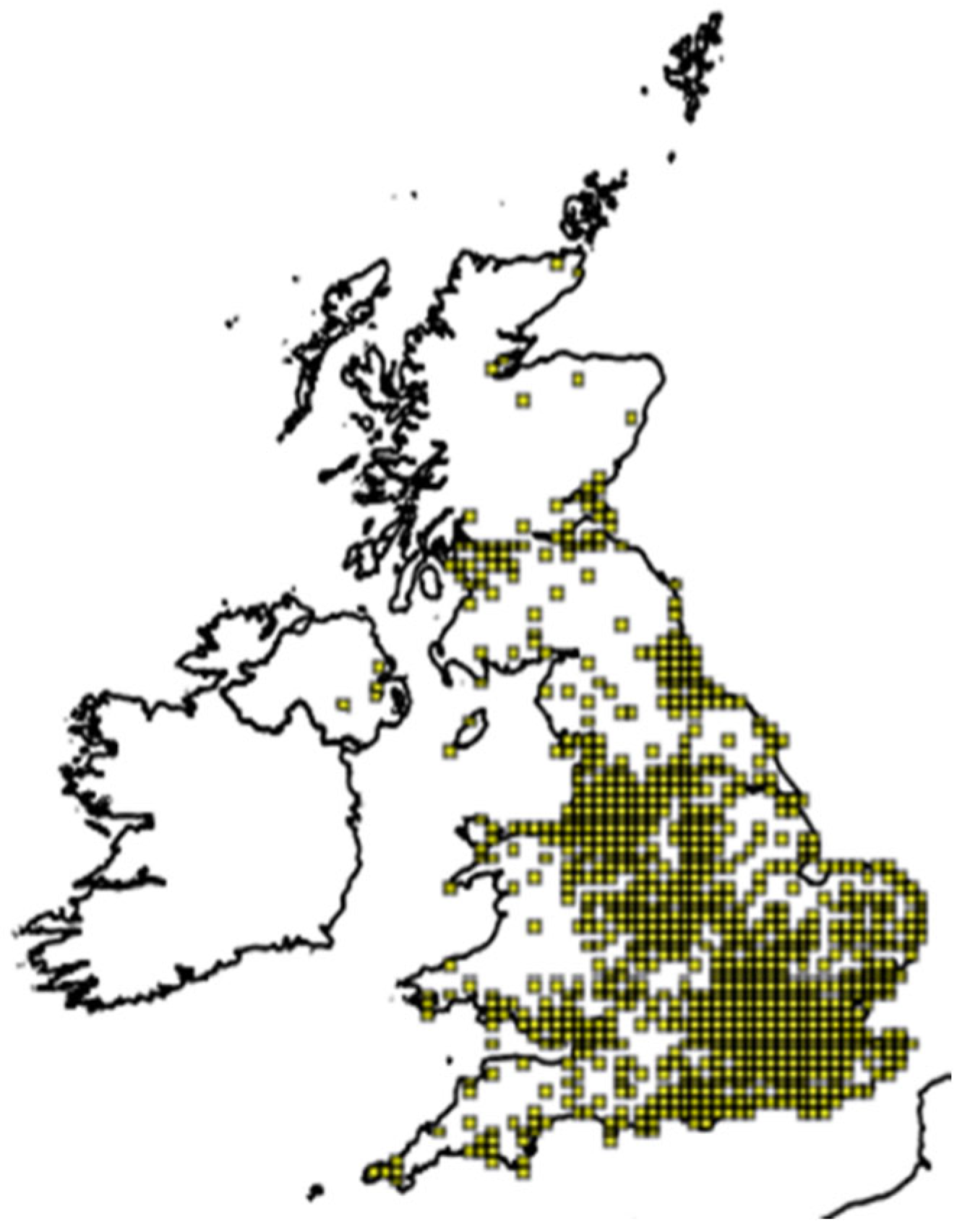
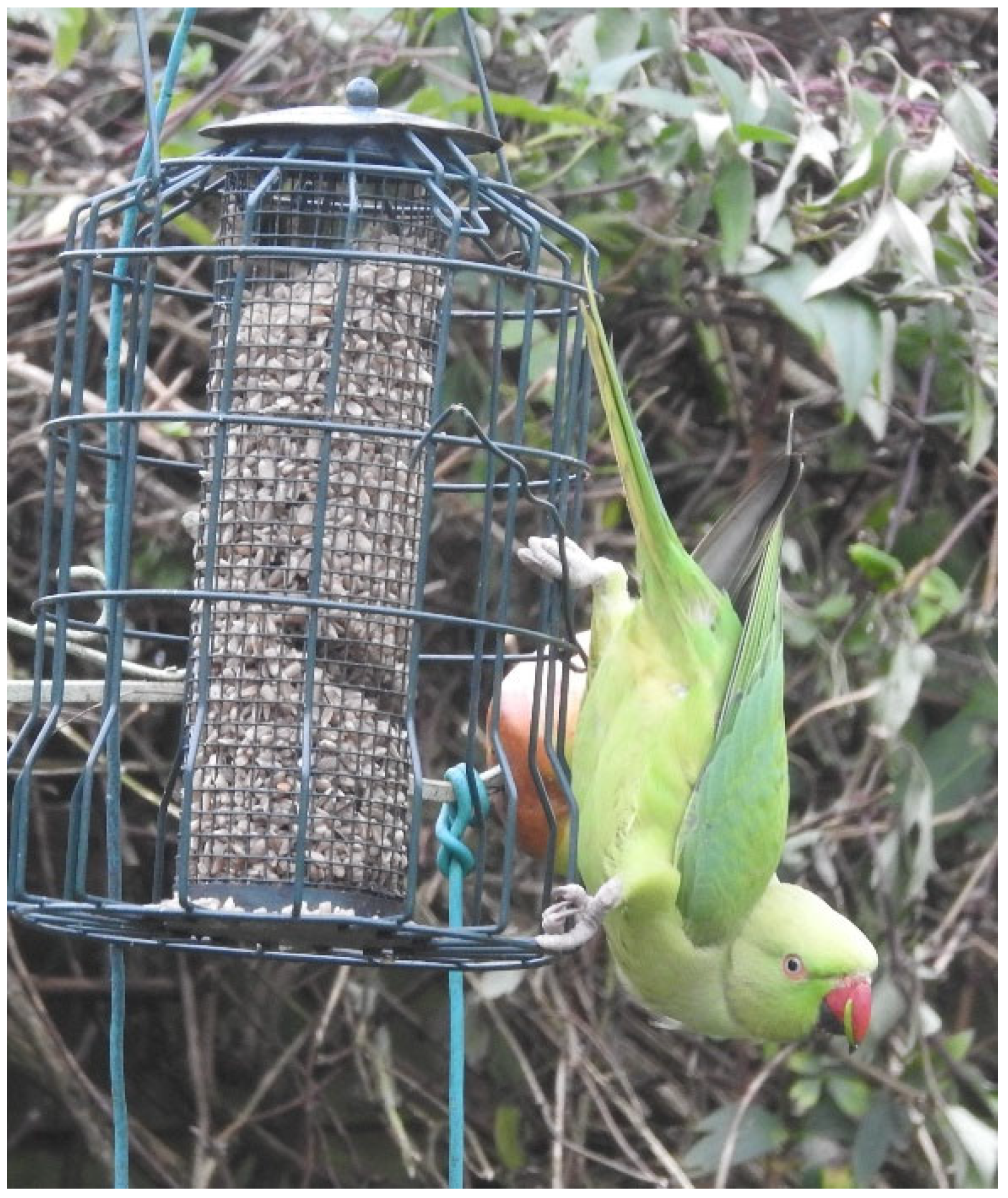
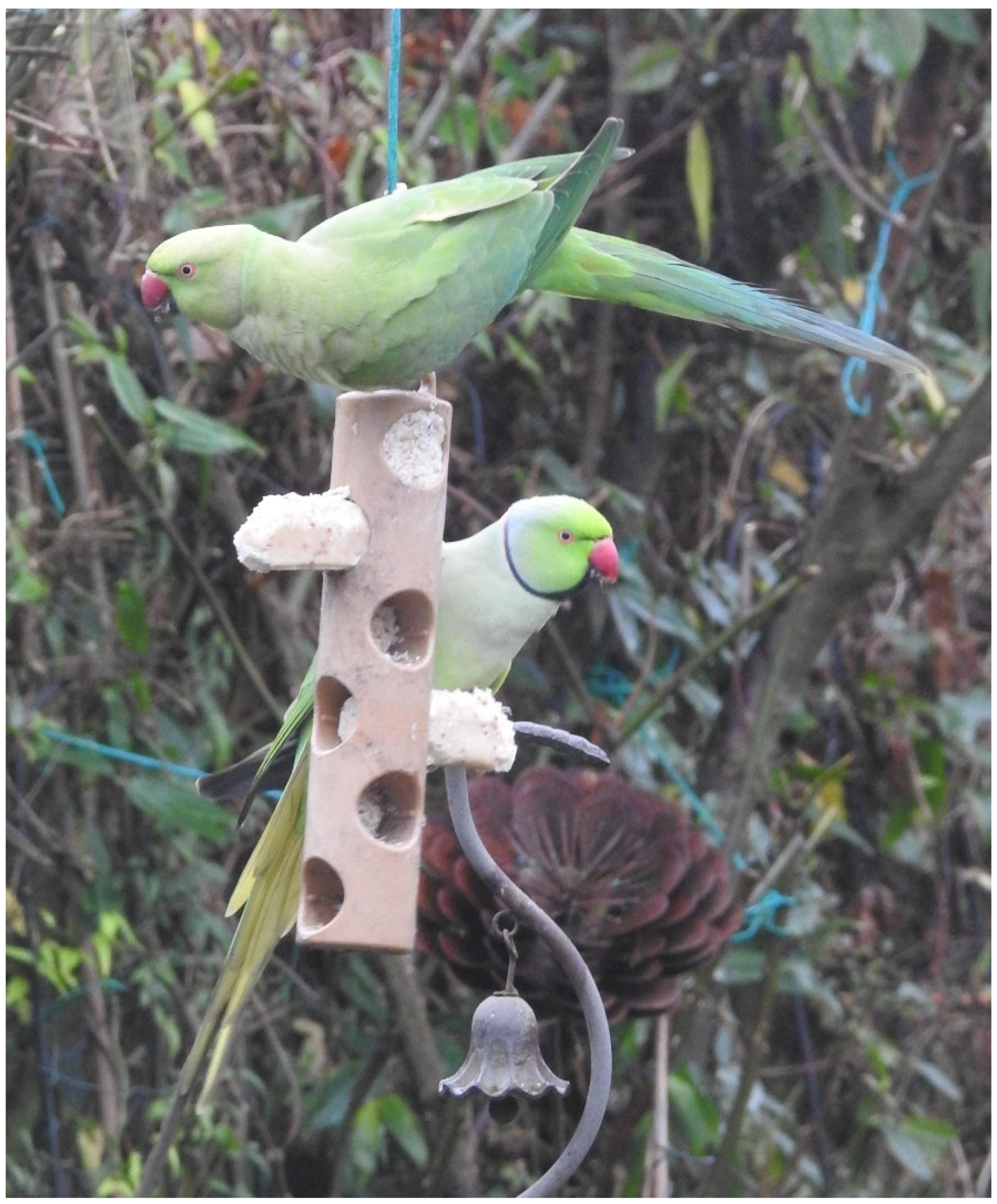
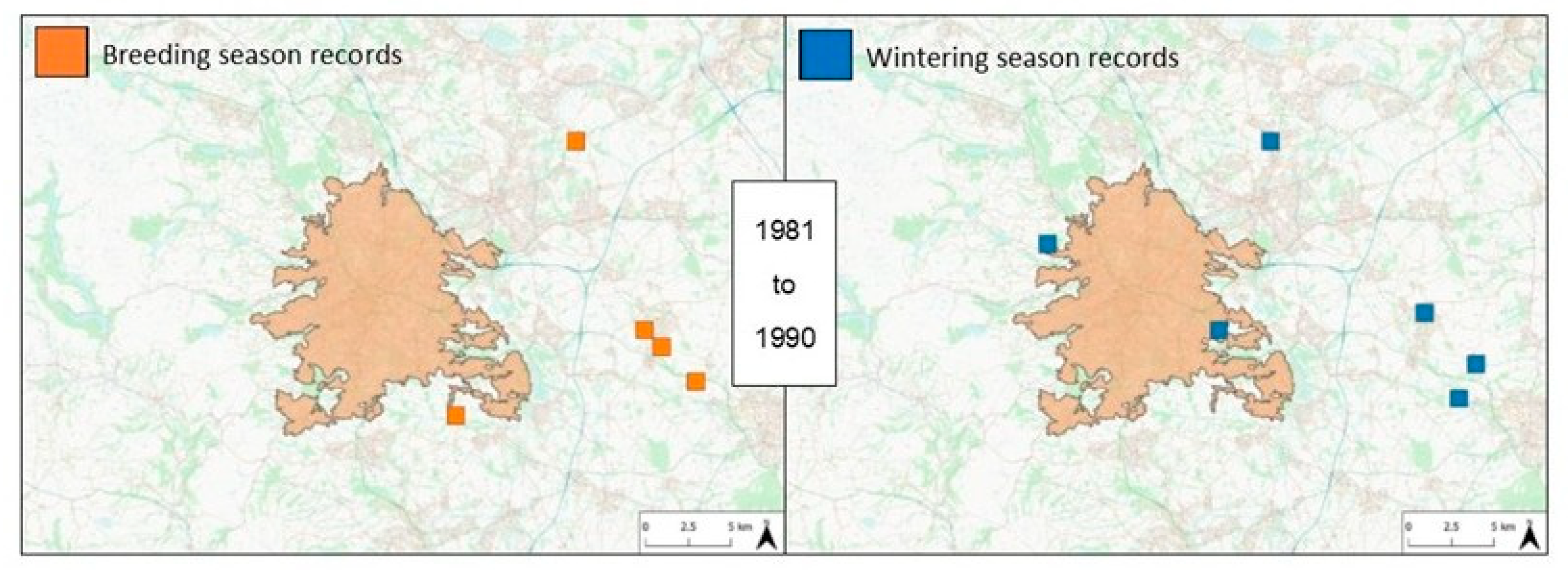
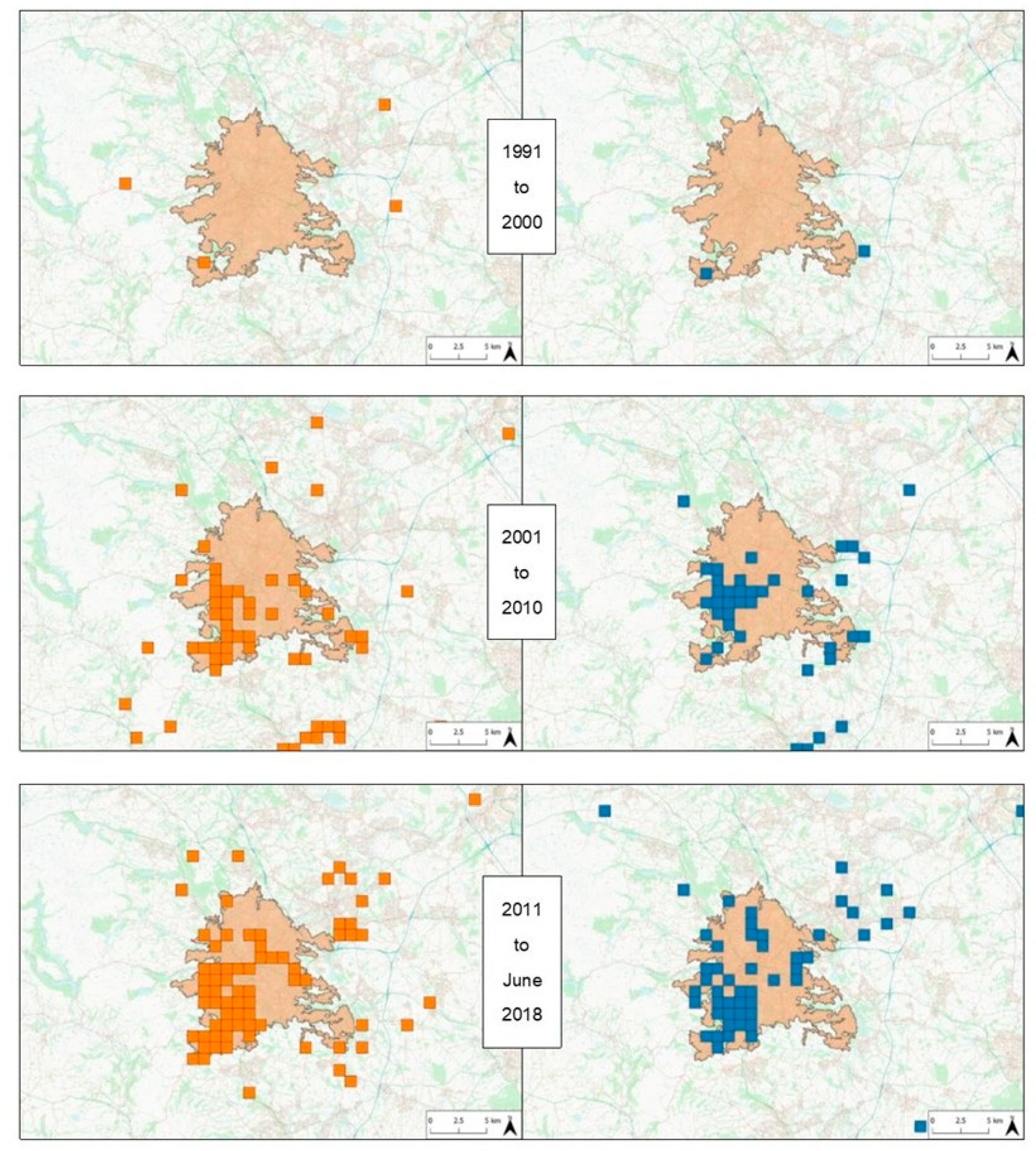

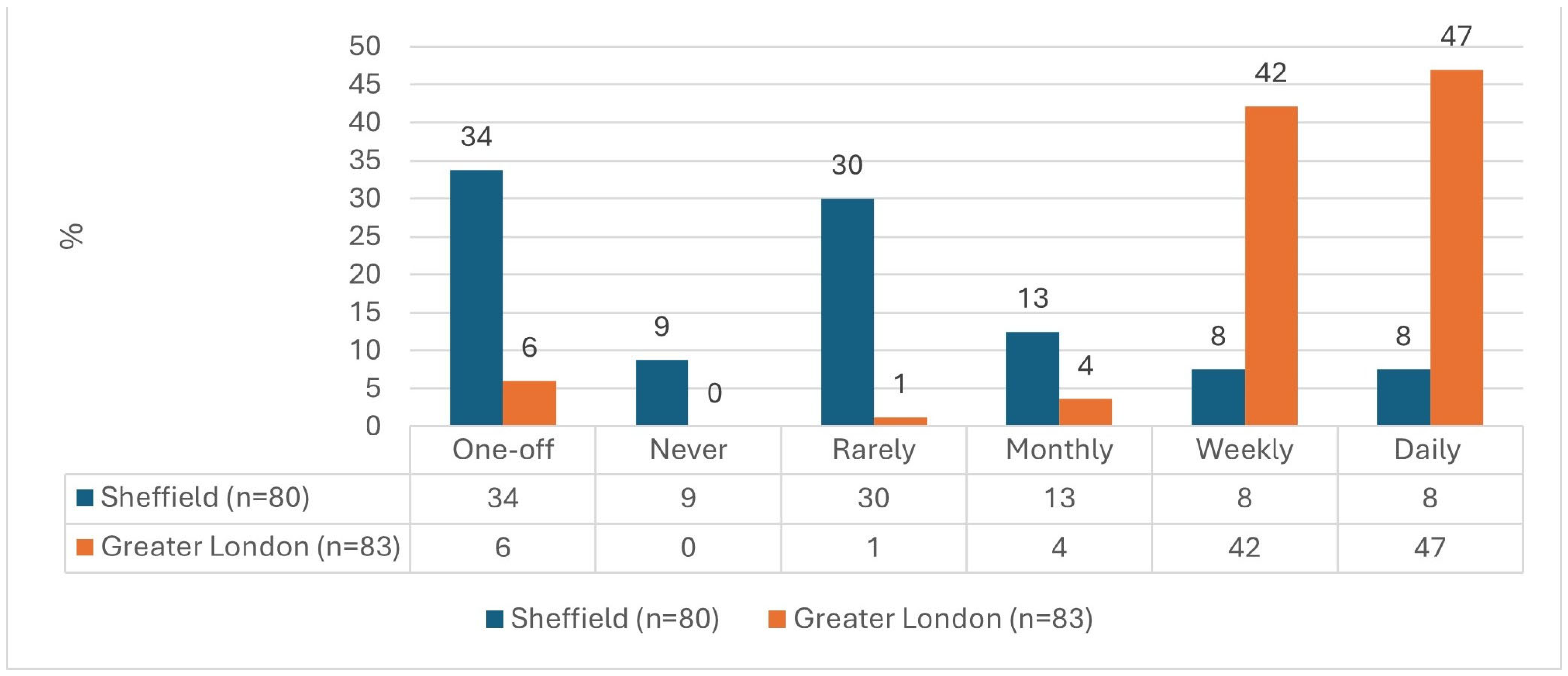
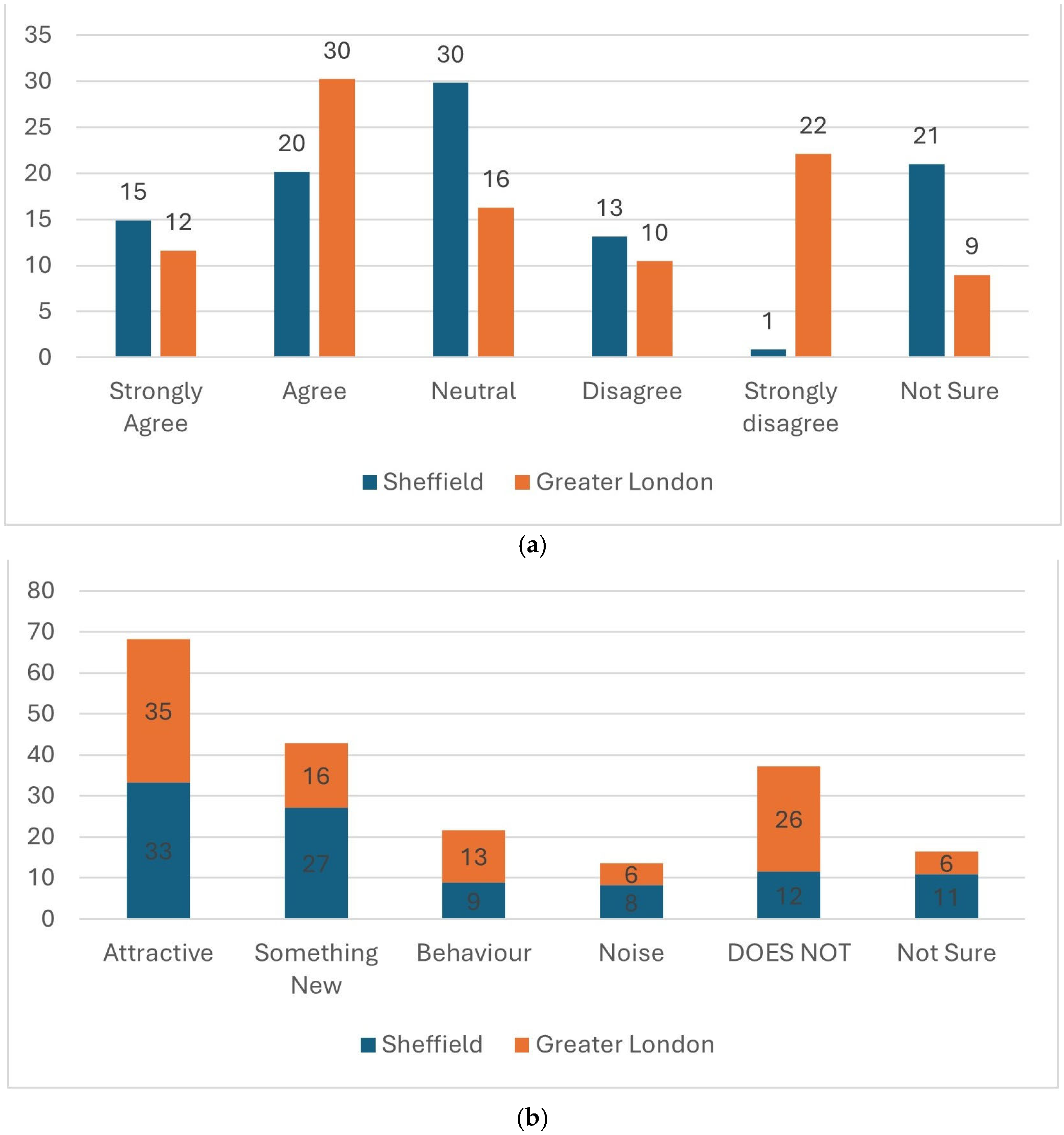
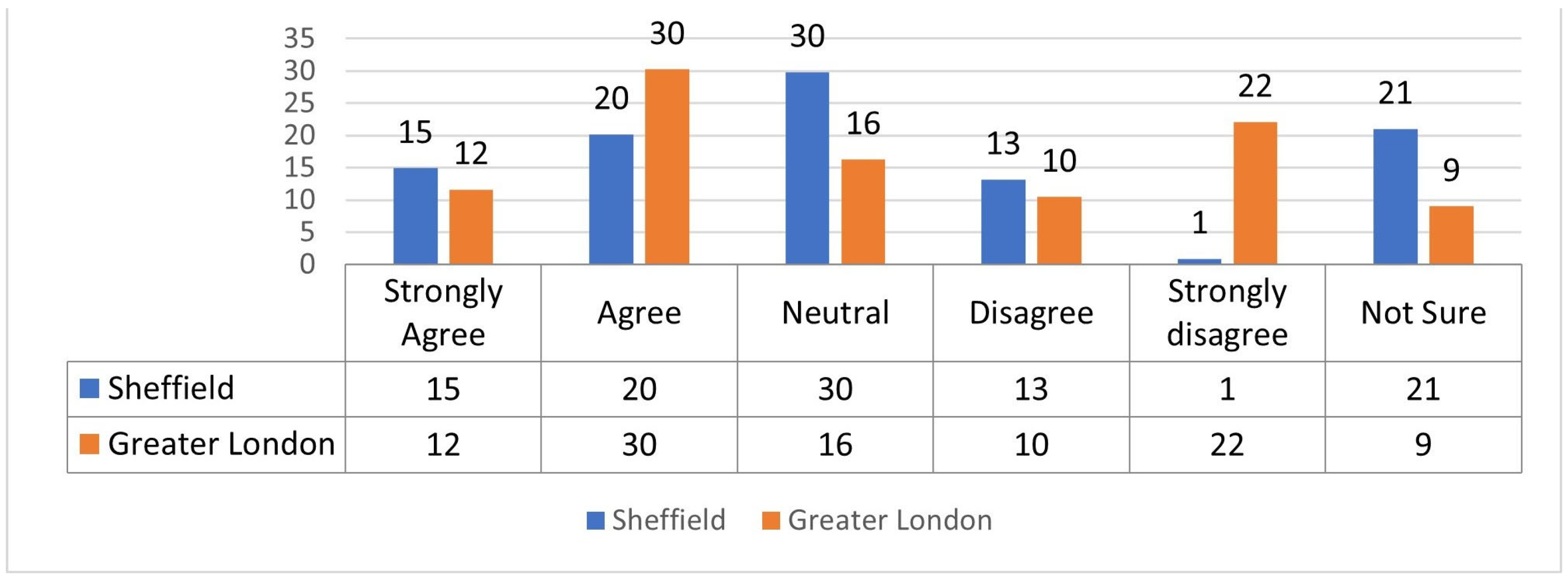
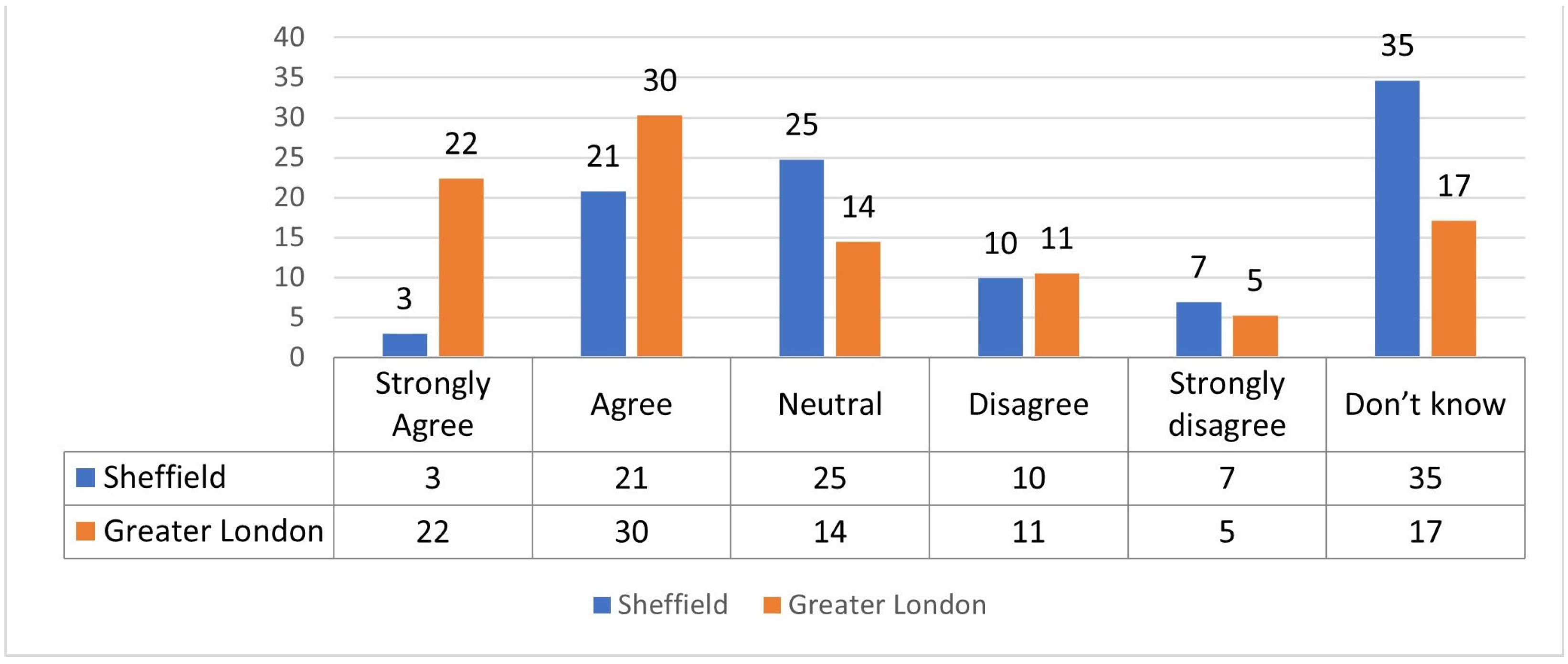


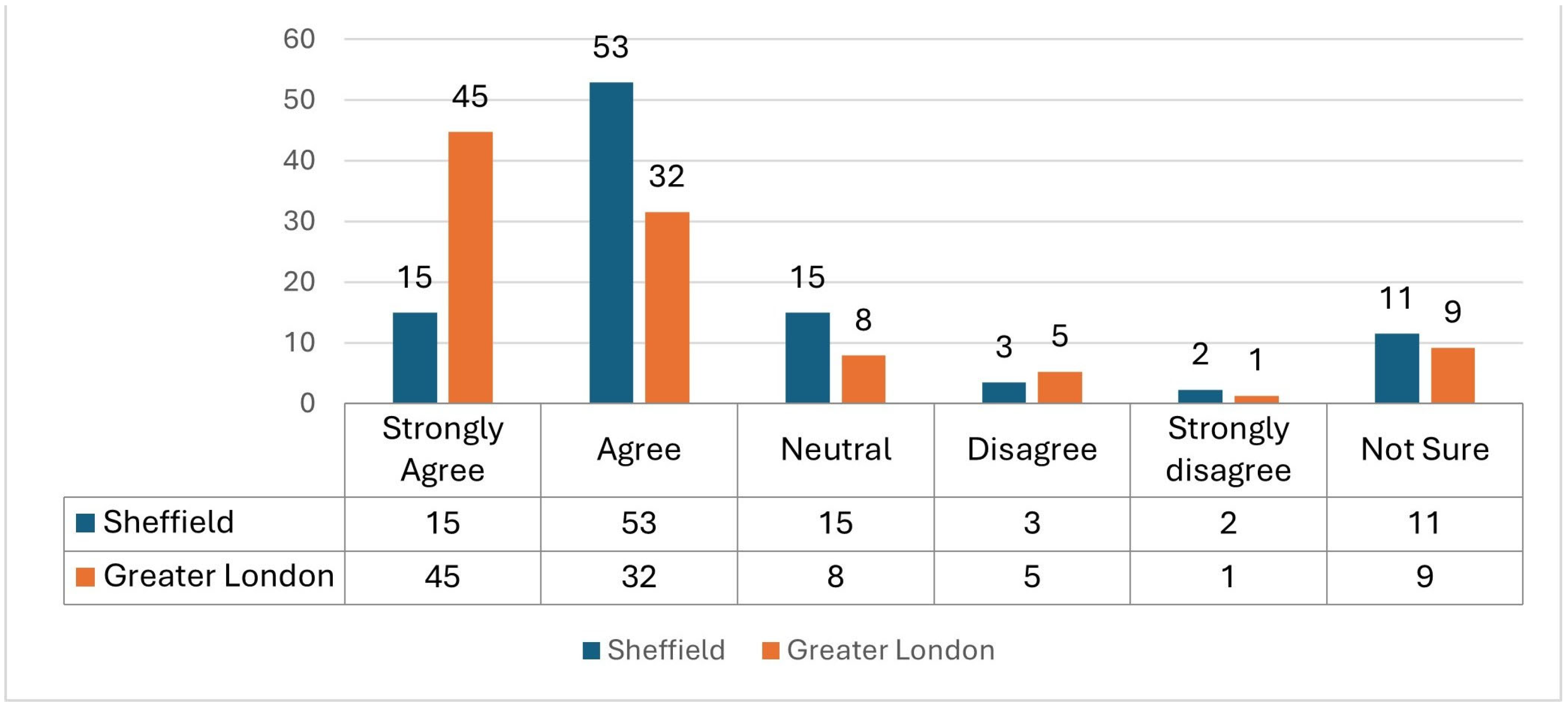
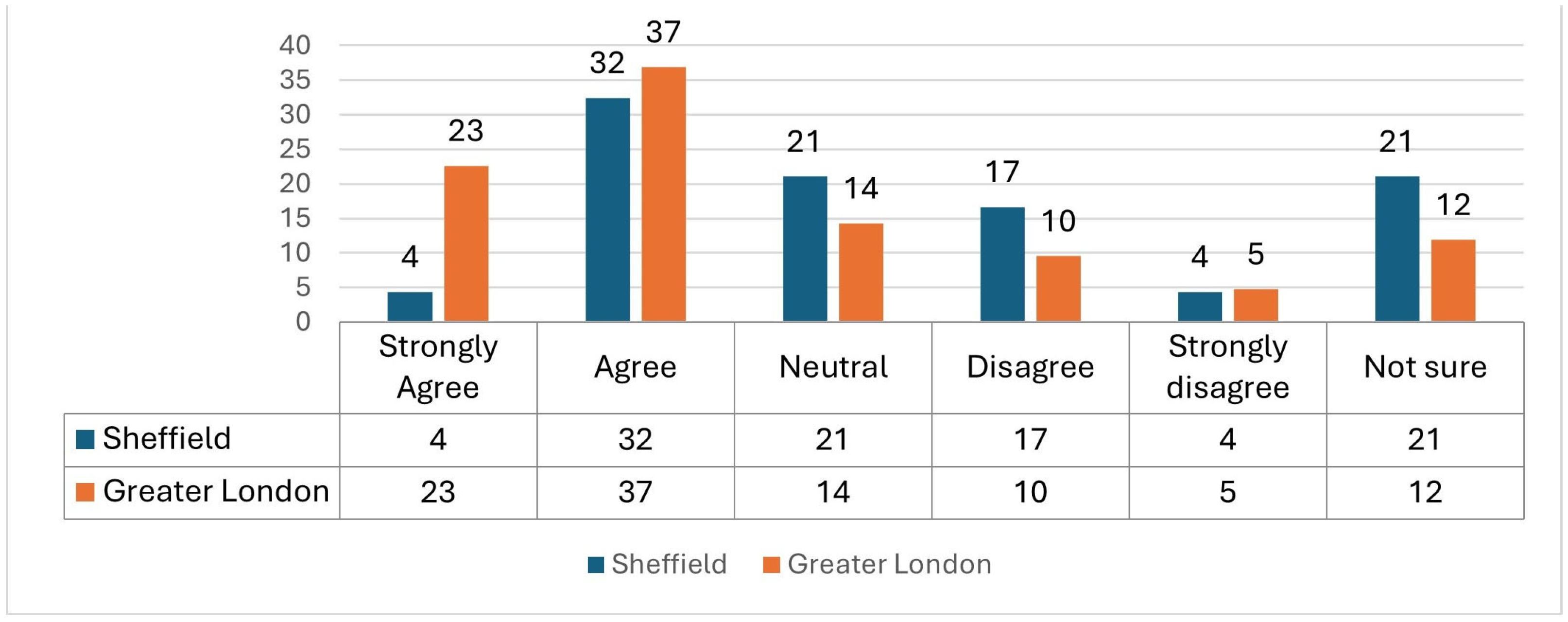




Disclaimer/Publisher’s Note: The statements, opinions and data contained in all publications are solely those of the individual author(s) and contributor(s) and not of MDPI and/or the editor(s). MDPI and/or the editor(s) disclaim responsibility for any injury to people or property resulting from any ideas, methods, instructions or products referred to in the content. |
© 2025 by the authors. Licensee MDPI, Basel, Switzerland. This article is an open access article distributed under the terms and conditions of the Creative Commons Attribution (CC BY) license (https://creativecommons.org/licenses/by/4.0/).
Share and Cite
Rotherham, I.D.; Watchman, M.J. Attitudes to Exotic Parakeets: A Comparative Case Study and Citizen Science Review. Diversity 2025, 17, 423. https://doi.org/10.3390/d17060423
Rotherham ID, Watchman MJ. Attitudes to Exotic Parakeets: A Comparative Case Study and Citizen Science Review. Diversity. 2025; 17(6):423. https://doi.org/10.3390/d17060423
Chicago/Turabian StyleRotherham, Ian D., and Miles J. Watchman. 2025. "Attitudes to Exotic Parakeets: A Comparative Case Study and Citizen Science Review" Diversity 17, no. 6: 423. https://doi.org/10.3390/d17060423
APA StyleRotherham, I. D., & Watchman, M. J. (2025). Attitudes to Exotic Parakeets: A Comparative Case Study and Citizen Science Review. Diversity, 17(6), 423. https://doi.org/10.3390/d17060423









